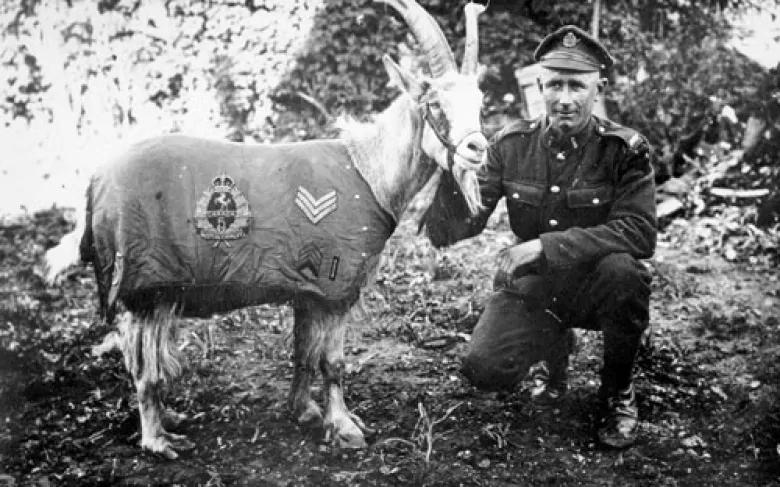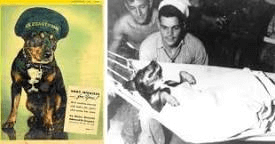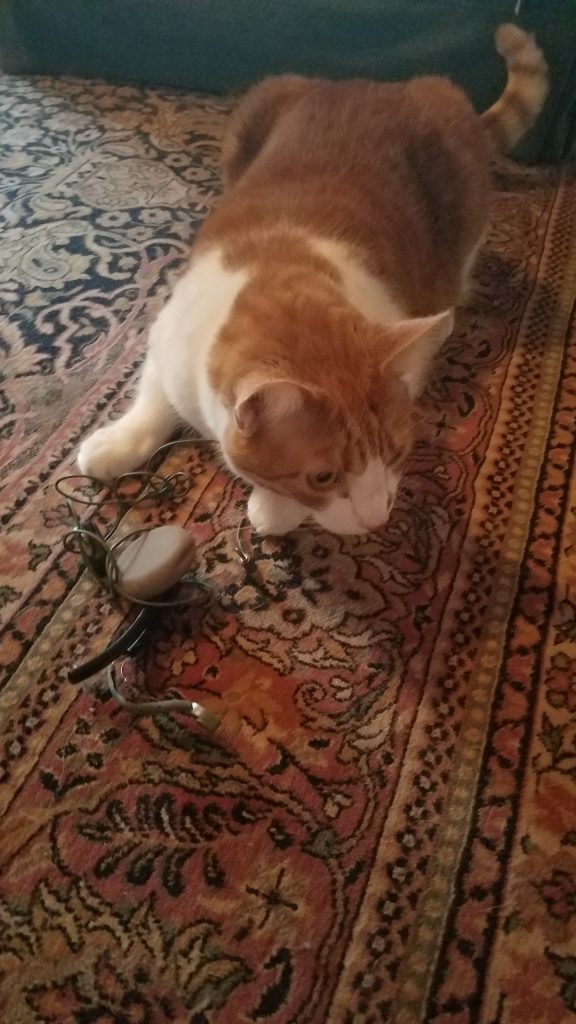Pete is mad at me because this blog is VERY late. But I couldn’t help myself. The deeper that I dug for stories and details about animals who served in the military, the more fascinated I became. Every time that I thought that I had finally found The Best story about an animal, there was another one just a bit further on the page.
Everyone knows that dogs are currently used by our Military, but I found that they, and everything from elephants to slugs have been used as far back as there have been wars.
Oxen were dressed up like dragons and set lose upon the enemy in 267 BC by Chinese warriors. Dogs were dressed up in turbans and long robes and lured the enemy out; the enemy thought that they were shooting at careless soldiers, only to be shot at by the hound’s owners. (Pete didn’t like this story but I think that the hounds got away.)
Monkeys were sent over walls with incendiary devices and fleas and flies were dropped as bombs by the Japanese onto China in WWII.
Elephants were used in war but mainly as intimidation; horses would panic because of the unfamiliar smell and well, elephants are intimidating to anyone in battle, I suppose. But! While the myth that elephants are afraid of mice may be untrue, they are afraid of the sound of squealing pigs and rivals of elephant owners made use of this fact.

My favorite insect story is about spiders. During WWII, bomb sites and rifle scopes weren’t made with etched lenses and regular thread couldn’t hold up to the jarring of firing. Spider web silk had been used since ancient times for nets, sutures and fishing line.
It was natural to turn to spider webs when they needed strong silk thread for sights in military weapons. After some trial and hard work, they discovered that black widow spiders were the best spinners for silken web thread. The silk was harvested from the spiders (garden spiders were too fast, so they used black widows), wound onto minuscule spindles and then sold to the government and put into the scopes. This was standard until they discovered a way to etch the crosshairs on the scopes, after the war.
The primary spider harvesters were in Ohio and California. In California, Nan Songer heard that the U.S. government needed silk so she began her spider silk harvesting operation in jars on her front porch. This was newsworthy, so the local newspaper wrote an article that was picked up by national papers. In the article, she lamented that she needed more spiders. Much to her surprise, she began receiving them from all parts of the country!
It was against the law to mail poisonous spiders through the post office but the government not only overlooked her outlaw ways, they offered her a contract for more silken web!
We used slugs because they are more sensitive to dangerous mustard gas; when soldiers saw the slugs shrink and stop breathing they knew it was time to put on their mask. They were more effective than birds at alerting them about dangerous gasses.
Soldiers used lightening bugs (or fireflies) because ten in a jar gave them enough light to read their letters from home or maps.
A goat from Saskatchewan named Sergeant Bill (Billy Goat) joined the Canadian army as a good luck mascot and finished as a hero. He was awarded the 1914/15 Star, the British War Medal and the Victory Medal for his four and a half years of service. He fought along side his fellow soldiers in the 5th Western Calvary Expeditionary Force from Canada.

A train load of new recruits spied him pulling his owner’s cart and asked Daisy Curwain of Broadview, Saskatchewan if they could borrow him for good luck. Her family owned a jewelry store, so didn’t need him for their farm and gave him to them.
After training, when they were being shipped out overseas, they didn’t want to give up Bill so they bought all the oranges from a local woman who was selling them to the people on the army base. They bought the oranges and the crate also. Into the wooden box went Bill, and they brought him aboard the S.S. Lapland in October 1914 as a crate of oranges.
Bill adjusted slowly to army life; when they first arrived, he ate the personnel roster. Then, he objected to the C.O. and butted him soundly in his hind end when he wasn’t looking. It was feared that he would be in the brig for quite sometime but he eventually learned to keep his horns (engraved with his battalion’s number) mostly to himself.
Sgt. Bill distinguished himself and was promoted to Sergeant because of his usefulness and bravery. He got trench foot/hoof with his men, he was hurt by shelling and had shrapnel wounds. He was shell shocked right along side his people and he recovered with them as well. He was gassed with them and he recognized the members of his battalion. He also liked to drink beer with them.
Sgt. Bill was on guard duty one night when he detected a German soldier who had sneaked into their territory and was making maps of the their encampment. He used his horns for good this time and butted him to the ground and stood on top of him until he was relieved by his fellow soldiers who took the enemy into custody.
He had superior hearing to his people and learned to recognize the sound of the planes. He was given an award because of a specific incident when his comrades didn’t hear the plane that was coming after them, he knocked all three men into the trench before jumping in with them. He saved them from annihilation as the shell landed where they had been standing.
He accompanied his men to Berlin and marched in the VE (Victory Europe) parade wearing a blue coat with Sargent's stripes. Sgt. Bill was also in his hometown parade, in full dress and he was arguably the star of the day.
His battalion was very sadly depleted when he returned to Canada and the men who returned were greeted with great warmth and happiness; he was one of the few original soldiers of the 5th who was still active.
I spent a long time researching Sgt. Bill. I thought that I had everything that I could possibly have on him for you but then I found an article that contradicted some of my end facts about Sgt. Bill after he died.
As I am not a journalist, and Pete is tired of waiting, I will simply tell you what I used to tell my children when they were young: He lived a long and happy life upon his return to Daisy.
(And when he died of natural causes, he was given to a taxidermist by Daisy and he is now the main attraction in Broadview Museum. He was very popular in death as well as life and school children used to climb up on him and ‘ride’ him until he got a little worn. Now, he is safely in a ‘No Touch’ exhibit. Or not.)
Of course we also used dogs throughout military history. In ancient times, they were given armor and fought in battle. They trained and worked beside humans. They were used to run down trenches with new, replacement communication cables during WWI when the lines of communication were damaged.
They often stood guard during the long, lonely, frightening nights with their people companions throughout the ages. During the American Revolution, the men took their dogs with them when the joined the militia without a thought because they were a team. Who better to be their brother in battle?
They were frequently used as couriers on the battlefields. One particularly stirring story was about an unnamed dog who had been sent to give a message but on his way found a wounded soldier. He stopped and refused to leave the soldier. The message wasn’t received, but the soldier was found and given medical aide because of his 4-legged guardian angel.
I chose to tell you about Sinbad the Sailor who was with the Coast Guard because, well, I love Barnegat, New Jersey and my niece is a member of the Coast Guard. Like most stories on this blog, it is a personal, loving choice.
Sinbad was a 40 pound mutt who was eventually described by reporters as “liberty-rum-chow-hound, with a bit of bulldog, doberman pinscher, and what-not. Mostly what-not.”

He served with the US Coastguard aboard the US Coast Guard Cutter Campbell, The Queen of The Seas, for its entire tour during World War II. He received numerous awards and was also court martialed twice and found guilty both times. Once of “conduct unbecoming a member of Campbellcrew” (for harassing sheep in Greenland) and several years later for going AWOL from his own promotion ceremony.
In 1937, he began his naval career as many do; unwanted and needing a home. He was a gift to Boatswains Mate A.A. “Blackie” Rother’s girlfriend but her landlord wouldn’t let her keep him. So, at the end of Liberty, at home port in New York City, Blackie and his buddy Ed Maillard brought him aboard the Campbell in a duffle bag.
The next morning Sinbad announced himself present by barking during muster while the ship’s captain was telling the men just how serious their mission to patrol the seas was. From behind the men, Sinbad the Sailor, who had been given his name the night before, when he was brought aboard, barked to show himself in attendance and ready for duty.
He was not thrown overboard for being a stowaway, but given the rank of Dog, 1st Class.
He quickly became part of the crew and was frequently found at the galley when it was chow time. He had a hammock for a bed because it was more stable than an actual bed on a ship that was heaving through waves on the Atlantic Ocean.
The first 3 years at sea were uneventful for Sinbad, except that he was court martialed and busted down to Seaman Pup for his sheep harassing in Greenland. He was also banned from ever setting paw there again. But he considered himself lucky, because the Greenlanders were seeking deadly retribution upon him and he was much safer drinking coffee in the galley with his shipmates on land.
Sinbad saw battle and was a critical part of the crew. While most of the time, his battle station was behind a ladder well or in his bunk, on February 22, 1943, the Campbell was protecting a convoy when they became involved in a cat and mouse game with allies and a German U boat in the North Atlantic. After a day of drizzle and poor visibility, the German sub’s periscope was spotted. The Campbell dropped a series of depth charges but in the end, it was the ship itself colliding with the sub that sunk it.
When the crew of the Campbell was rescuing the Germans with their lifeboats in the water, they got a better look at the cutter and they realized that the Campbell had been severely damaged. Half of the crew had to be evacuated to a Polish ship.
Commander Jimmy Hirshfield deemed Sinbad an ‘essential’ member of the crew and decided that Sinbad was to stay aboard ship during restoration because his men felt so strongly that they were unsinkable with Sinbad aboard.
That day he had been on deck all day with his crew and he deserved to remain. All was well and they were reunited with the rest of the crew a few days later in St. John’s, Newfoundland.
His valor and good conduct was a good counter balance to another of his unfortunate incidents when he pulled the lanyard of a 300lb depth charger and nearly sunk the ship.
Sinbad was beloved by his crew and the world not just because he was a dedicated sea dog, but because he was as rowdy as any sailor who ever sailed the seas. His tales of rowdiness are long and pretty much run along the vein of being a hard drinking dog.
He had a fund for taxi rides home during Liberty in the Quarterdeck Shack because he reportedly would take cabs back to the ship. (I assume that he was aided by his fellow shipmates when he had to hail the cab and give instructions.)
One night on Liberty, he was reported as a ‘dead dog on the street’ by a woman in Manhattan only to be discovered by a policeman as a ‘dead drunk dog in the gutter.’ His fondness for draft beers and Boiler Makers (beer and a shot of whiskey) was legendary, if not exaggerated. Those were different times, now we would say that he was an abused animal but back then, he was hailed as ‘one of the boys’ and he was beloved enough to be invited to their revelry as well as their work during war time.
His main job aboard ship was his companionship and distraction from the horror of war. He gave his love to the crew just as our dogs give it to us, with an open heart and enough naughtiness for us to know that he was his own dog.
He loved to play and he would hoard three inch metal washers. When he could get someone to play with him, he would give one to them and they would balance it on his nose then he would give a quick jerk and catch it in his mouth.
He was promoted a final time to Chief Dog. The captain arranged a ceremony in their home port in New York but he decided that he had enough of the publicity and photographers and ran down the gangplank and out into New York City, presumably to find another beer and better company. He was promptly court martialed again and demoted back to his previous rank upon his return.
He earned, among other awards, 5 Battle Stars during his time on the high seas. He retired on September 21, 1948 to the Barnegat Coast Guard Station in New Jersey where he continued to swill beer with his mates and keep everyone safe with his good humor and good luck. He passed away on December 30, 1951 at the age of 14. He had a funeral with full military honors and was buried at the foot of the flag pole at the Barnegat Coast Guard Station. A bronze plaque honors him there.
The Campbell was decommissioned in 1982 and replaced by another that is stationed out of Kirby, Maine. But Sinbad is not forgotten. There are paw prints painted on the main deck and when the cutter is underway, a white flag flies that says, “Sinbad Lives.”
Eddie Lloyd, the editor of the old Coast Guard Magazine said: “Sinbad was a salty sailor but he’s not a good sailor. He never rated gold hash marks nor good conduct medals. He’s been on report several times, and he’s raised hell in a number of ports. On a few occasions, he has embarrassed the United States government by creating disturbances in foreign zones. Perhaps that’s why Coast Guardsmen love Sinbad – He’s as bad as the worst and as good as the best of us.
Cats are less flamboyant that dogs in military history. Which doesn’t mean that they were any less important. They were fantastic workers and were responsible for keeping the mouse and rat populations down so our military personnel could eat. They also provided much needed distraction from the hells of war.

They seemed to be more often on ships than land and unfortunately, there seems to be two ways that a ship’s cat disappears; it goes down with the ship or it disappears at a port. Both scenarios seem to typical ‘cat.’ Dedicated and independent.
The CIA foolishly tried to use a cat for espionage in the Kremlin in the 1960s. In operation Acoustic Kitty; they implanted the cat with listening devices in his ear and on his collar. Back then, the electronics were bulky and had poor reception.
Like most government programs, they overreached, and were short-sighted: they thought that could control a cat. The theory was that they could bug a cat and it would wander through the building collecting information. It didn’t. It was frequently distracted and when it ate, the noise interfered with the reception.
After wasting millions of taxpayer dollars and more than likely annoying the poor cat, they decided to give up, because, unfortunately, when they sent the cat on his first ‘mission’ to go and listen to a couple of men sitting on a park bench, the cat was hit by a cab. The cat could not be saved, nor could the operation.
I wanted to finish this with a heartwarming story about a cat. I am afraid that the only heartwarming story that I found is a recent one. Pfc. Hammer recently was brought here from the Middle East and he is very happy and loved with his owner in Colorado. He was aided by Alley Cat Allies and Military Mascots.
sadly no pictures avalible
There are far too many stories of animal loyalty and bravery and utilitarian usefulness for me to write even half of them. I don’t have room and Pete doesn’t have patience enough for me to write about horses! But! A horse in Korea learned the route between camps so well that it could carry supplies between camps without a person. Even snakes were used/tolerated in jungle trenches because they ate mice and other crawlies.
The fact that Sinbad and Sgt. Bill were happily included as drinking buddies tells us what we need to know and what we already know; that our animals are our friends. They distract us in times of great stress and give us a loving swat when we need a hug.
Hammer was grabbed by the person nearest and slid under the protective gear when his mates were being bombed. He was family. They are the best part of us; the unexpected, interesting, distracting friends who give our brains a rest and comfort us when we can’t confide in people. They remind us of home and the reason that we fight; to protect our country, our homes and our families. Because they are family and their dedication to us inspires us when we are afraid and we need comfort.
Every animal story that touches our heart is one that is compelling because of mutual love.Links:
https://warisboring.com/even-animals-needed-gas-masks…
https://www.military-history.org/articles/war-culture…
https://warhistoryonline.com/instant-articles…
slugs of war detecting gas and other creatures who helped win wars
https://roadstothegreatwar-ww1.blogspot.com
sergeant bill the goat
https://www.warhistoryonline.com/world-war-i/stubby…
https://roadstothegreatwar-ww1.blogspot.com
https://americanhistory.si.edu/blog/how-did-animals….
https://www.historyhit.com/animals-used-for-military…
https://www.lifewithcats.tv/2011/11/11/11-11-11-remembering-the-countless-cats-who-also-served/
http://petslady.com/articles/hammer_time_cat_iraq_62910
http://www.operationwearehere.com/Pets.html
https://www.dogsondeployment.org/
Thanks for sharing with us all these stories about animals in the military. We loved them all.